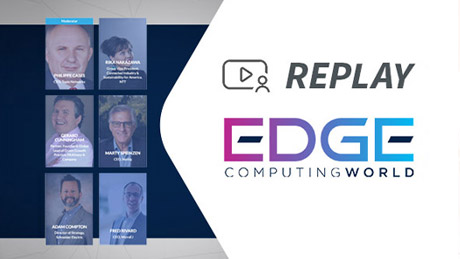In today’s fast-paced technological world, it’s crucial to stay ahead of the curve in the embedded systems industry.
In this podcast episode, Amelia Dalton from EE Journal interviews Semir Haddad, our Chief Product and Strategy Officer, on the current and future biggest influences of embedded systems development.
Semir highlights the three major trends that are impacting the embedded systems industry: sustainability, containerization and servitization.
- Sustainability has become a top priority for companies and developers, as more and more organizations make commitments to reduce their carbon footprint.
- Containerization offers embedded systems enhanced portability, efficient resource utilization, and simplified maintenance through isolated, lightweight environments.
- Servitization refers to the trend of transforming products into services, which offers numerous benefits for both manufacturers and consumers, including recurring revenue and anticipating customer needs.
On the other hand, Semir explained the importance of optimizing hardware resources by using the right software technology.
Hit play and explore the future of embedded systems, the impact of sustainability and servitization, and how our software container, MICROEJ VEE, is revolutionizing the industry:
Click here to download this episode.
— TRANSCRIPT —
Amelia Dalton: Hi, Semir. Thank you so much for joining me.
Semir Haddad: Okay. Very good. Thank you, Amelia, for having me on this podcast.
A.D: Absolutely. Okay. So, let’s first talk about some upper level stuff. So, Semir, what do you see are the biggest influences on embedded systems development going into the next year?
S.H: Oh, yeah. Okay. 2023 would be certainly an interesting year. Some people would say, of course, the short-term influence that we see, would be supply chain and inflation. [They] would be a big deal, but these are more like short term issues. And what we see in fact is that more and more customers and more and more people in the embedded space are concerned with more longer-term issues. That impact all of us. One of them, for instance, is sustainability. How to build sustainable product and how to meet all the pledges that everyone does. If you look around us, all the major companies have made pledges about carbon reduction and greenhouse gas reduction. It’s a very big deal for everyone and we see it more and more coming to the embedded space and embedded people and embedded developers. And then the second trend that we think is going to happen in 2023. That’s a trend that was in the making for a long time. But now, we really see as reaching the shared products and, let’s say, really becoming the reality for all developers is a servitization. What I mean by that is how people are turning products into services. For instance, when you have a hardware product, the old model was you sell it and then you forget about it and customer and the end user, we just use it, and that’s all. More and more, we see developers and companies trying to bring some services into the products and make it get more flexible, credible, and with a type of recurring model. So it’s very interesting because for us as a software company, it’s definitely something that we can enable. And this servitization requires lots of flexibility in the software development.
A.D: Okay. So, Samir, let’s talk about this servitization. How do you think it helps manufacturers of embedded systems?
S.H: Yeah. For the manufacturers, it takes a great lot because they always have being looking for a way to generate recurring revenue. As I said, the old model for manufacturers was you sell a product and then you forget about it and then you hope that your customer will buy another one later, try to improve it. That’s all. But you basically, you lose sight of the product. With servitization comes many benefits. The first benefit is that you keep the contact with customer because you keep upgrading the product and keep bringing services to the customer. So that’s the first aspect, like, this customer intimacy. The second thing is that you can generate recurring revenue. So these manufacturers usually trying to sell you services or maintenance and so on. That’s their attempt today to get some recurring revenue. But with servitization, this can be really something that happens during all the life of the product, and it can be also materialized by applications or software application that you can have on your product and provide some additional services, some additional customization for the end user. And that’s the benefit for the manufacturer, but there is also, of course, a benefit for the consumer. As we all see with our mobile phones, if everybody likes smartphones, that’s because you have all these apps that can help you customize your experience and get more of your product. And that’s what is going to happen to all products.
A.D: So Semir, with AI connected systems and similar demands on edge processing what are your recommendations for how embedded developers can keep up?
S.H: We talked about servitization of course. It’s a big constraint for the engineer that wants to develop the system. We need lots of software and some software resources. And then you can bring all the innovation that is coming as well in term of AI and connectivity and now you have, like, 5G, you have WiFi 6, all these things. I think the most important thing for the developer is really to make sure they maximize the use of their hardware resources. And they don’t over design. And this is very important because all this model of servitization works if it has a good right price point. It’s important to take advantage of the technology that enable them to optimize their implementation and not over design, not go for, I would say, mobile phones [systems] for every device, that would be completely overkill. They [need to] use the right software technology to make use of this innovation, make use of AI, make use of connectivity, but still have a very efficient implementation. For instance, the software platform MicroEJ that we develop is very optimized for embedded devices, and we offer more or less the same services as a rich operating system with a very small footprint with things like virtualization, containerization, and also integration of many of all the major functions that you need for an IoT product.
A.D: Okay. So talk to me about MicroEJ’s take on containerization for embedded in particular.
S.H: Yeah. Sure. As I mentioned, MicroEJ is a software platform developed especially for the Internet of Things and for embedded devices. And what we bring is virtualization and containerization for small devices. If you think about containerization, it was really the backbone of success of cloud native technologies. All the cloud-based systems are based on some kind of virtualization and containerization, like Kubernetes and Docker, for instance. Basically, the cloud people develop microservices that are independent from the hardware and are very flexible and very portable. This is what you want to achieve for embedded system, especially in the era of servitization. You want to develop a device that is software defined, that is very flexible, very portable, independent from the hardware, so your software can be really disconnected from the underlying hardware. And let’s come also with agility in development and also a product that is evolutive and fits the usage of the end customer. Our take on that is, let’s take all these technologies, this concept and benefits that are already successful in the IT world and the cloud world and make them available for the embedded space. We started from the ground up instead of starting from let’s say, cloud technology and trying make them fit them with hardware in the small devices like some people do, and it really does not work. We started from the ground up from really the embedded devices. In fact, our very first implementation was on an 8-bit processor. It was a very long time ago. Now we support all kind of 32-bit processors for microcontrollers based on Cortex M0 up to Cortex M7 processors. We even support Cortex-A class of products, and we will very optimize the container. We call it the MICROEJ VEE for Virtual Execution Environment that also allows containers within the container. We have the full benefit of containerization and virtualization within the footprint of a very small embedded device.
A.D: Okay, Sameer. So let’s talk about CES. What did MicroEJ bring to CES this year?
S.H: Yes. It was a very exciting CES, and we had lots of traffic at your booth with many people coming and looking at all demos. We had lots of demos with customers. We had some Polar watches, it is a smartwatch manufacturer and they’re using MicroEJ. We had also a smart cooker with Moulinex, which is an SEB company, one of the leading small appliance manufacturer in the world. We had another demo from our customer Landis+Gyr for smart meter, which is a very smart electricity meter that connects to the cloud and can upload services and applications. It’s a very good example of servitization. And as well as some other demos, like, another one with Decathlon, which was a bike with a bike controller and also more in the industry space with the Schneider Electric, which is one of our partner as well. So these are the customer demos showing the breadth of application that MICROEJ VEE can support. And then we had also some very nice demos with partners. For instance, one of them is NXP, the semiconductor company. We had the cellular modem demos with Telit and Thales. These are more for the engineers to showcase how you can connect to cellular network and how you can use the container to build applications without disrupting the cellular connectivity. And then in term of AI, we also had a demo with Au-Zone, which is an AI company and partner that provide image recognition and time series analysis with AI, and this demo shows how you can use a camera to do recognition on some playing cards with MicroEJ. MicroEJ uses a container to enable the integration of the application. So, yeah, lots of demo, lots of very interesting partners and customers. And overall, in fact, a very successful CES which central theme was software defined everything. It’s kind of an illustration of what we are doing with these partners and with these customers. We are enabling them to build software defined products and software defined things.
A.D: Excellent. Okay. 1 last question here, Semir. How do you think embedded teams can do more to build sustainable products and green software.
S.H: Yes. As I said at the beginning, sustainability is very important now. I have in top of mind, in fact, many consumers, and many companies as well. So it’s important and it’s a challenge to reach sustainability. The best way to address sustainability is to design very efficient products and very efficient in two ways. The first one is from the bill of material point of view, because more or less 80 percent of your CO2 comes from drilling [the components of] the product because they have short lifespan. If you look at the industrial product that have a longer lifespan, usually 50 percent [of carbon emissions] is about production of the product and 50 percent is about life of the product, when you would speak about power consumption. So you need to minimize both the cost of the product, the bill of material, and you need to minimize as well the power consumption. And the best way to do that is, as you said, to have an approach of green software, which means that you don’t over design. You don’t take the shortcut in terms of product design and software enablement. So for instance, it’s tempting to use very big processors with high performance OSs, like Linux, because it’s just easy. But usually, that’s resulting in very costly and overly powerful devices. So it’s better to start with optimized solutions, like, MicroEJ, for instance, and build your product from efficient electronics using microcontrollers and doing just what you need to design your product and provide the service that you want to provide.
A.D: Excellent. Alright, Samir. It is time for your off the cuff question. Now, I know you will have an opinion about this one. So, Semir, if you could have one meal right now. It doesn’t matter if it’s on the other side of the world. You need a passport to get there. The restaurant is closed. Semir, what would you have?
S.H: If I could have a meal right now, so I will tell you and it’s personal. In fact, I’m French, as you can hear, but I also have North African origins. My father is from Tunisia. And one meal that I would like to have right now, it’s a very nice couscous from Tunisia. And I know it’s very difficult to find. I live in the US, in San Francisco, it’s absolutely impossible to find here. So yeah, that’s one I would like to have. And I hope I can get it someday.
A.D: Excellent. Well, Semir, I think that’s all I have time for today.
S.H: Thank you so much for joining me. Okay. Very good. Thank you, Amelia. Thank you as well.
Amelia Dalton has worked in electronic engineering journalism for over fifteen years. She is the host of EE Journal’s long-running Chalk Talk Webcast series as well as the weekly electronic engineering podcast, Amelia’s Weekly Fish Fry. Amelia is especially passionate about electronic engineering that can help the greater good – from artificial intelligence to nanotechnology to new material innovation and beyond.





